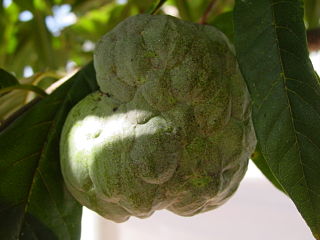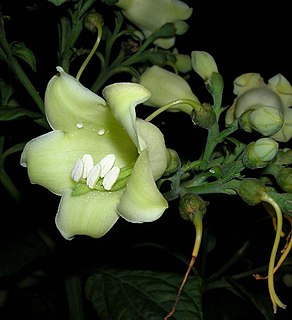
Canna or canna lily is the only genus of flowering plants in the family Cannaceae, consisting of 10 species. Cannas are not true lilies, but have been assigned by the APG II system of 2003 to the order Zingiberales in the monocot clade Commelinids, together with their closest relatives, the gingers, spiral gingers, bananas, arrowroots, heliconias, and birds of paradise.

The Mathematical Association of America (MAA) is a professional society that focuses on mathematics accessible at the undergraduate level. Members include university, college, and high school teachers; graduate and undergraduate students; pure and applied mathematicians; computer scientists; statisticians; and many others in academia, government, business, and industry.

Malvaceae, or the mallows, is a family of flowering plants estimated to contain 244 genera with 4225 known species. Well-known members of economic importance include okra, cotton, cacao and durian. There are also some genera containing familiar ornamentals, such as Alcea (hollyhock), Malva (mallow) and Lavatera, as well as Tilia. The largest genera in terms of number of species include Hibiscus, Sterculia, Dombeya, Pavonia and Sida.

The Annonaceae are a family of flowering plants consisting of trees, shrubs, or rarely lianas commonly known as the custard apple family or soursop family. With 108 accepted genera and about 2400 known species, it is the largest family in the Magnoliales. Several genera produce edible fruit, most notably Annona, Anonidium, Asimina, Rollinia, and Uvaria. Its type genus is Annona. The family is concentrated in the tropics, with few species found in temperate regions. About 900 species are Neotropical, 450 are Afrotropical, and the remaining are Indomalayan.

Gentianaceae is a family of flowering plants of 103 genera and about 1600 species.

The Loganiaceae are a family of flowering plants classified in order Gentianales. The family includes up to 13 genera, distributed around the world's tropics. There are not any great morphological characteristics to distinguish these taxa from others in the order Gentianales.

Strychnos is a genus of flowering plants, belonging to the family Loganiaceae. The genus includes about 100 accepted species of trees and lianas, and more than 200 that are as yet unresolved. The genus is widely distributed around the world's tropics and is noted for the presence of poisonous indole alkaloids in the roots, stems and leaves of various species. Among these alkaloids are the well-known and virulent poisons strychnine and curare.

The genus Macrocarpaea, with 105 species and two hybrids of 0.5 m herbs, shrubs, epiphytes and small trees to 10 m tall, is the largest genus of the tribe Helieae of the gentian family (Gentianaceae). Species of Macrocarpaea have diurnal and nocturnal pollinators, visited during the day by hummingbirds, insects and butterflies, and at night by bats, moths and many different kinds of insects. The common name for the genus is 'Moon-gentian'. No species are known in cultivation.
Richard John Alexander Talbert is a British-American contemporary ancient historian and classicist on the faculty of the University of North Carolina at Chapel Hill, where he is William Rand Kenan, Jr., Professor of Ancient History and Classics. Talbert is a leading scholar of ancient geography and the idea of space in the ancient Mediterranean world.
Neuburgia is a genus of plants in the family Loganiaceae. It is native to the Bismarck Archipelago, Caroline Islands, Fiji, Maluku Islands, New Caledonia, New Guinea, Philippines, Solomon Islands, Sulawesi, and Vanuatu. It contains the following species :
Pseudoxandra is a genus of plant in family Annonaceae. It contains the following species:

Thismia is a genus of myco-heterotrophic plants in family Burmanniaceae, first described as a genus in 1845. It is native to East and Southeast Asia, New Guinea, Australia, New Zealand, and the Americas.

Enchylaena tomentosa, commonly known as barrier saltbush or ruby saltbush, is a small native shrub of Australia.
Alfred Struwe was a German actor, best known for his television role as Dr. Alexander Wittkugel in Zahn um Zahn.

Voyria, commonly known as ghostplants, is a genus of 20 species of herbaceous perennial plants, belonging to the family Gentianaceae. They are mostly native to warm temperate and tropical regions of the Caribbean, Central America and South America, except for V. primuloides, which is found in West and Central Africa. V. parasitica reaches as far north as the Everglades in Florida.

Hellenia is a genus of plants in the Costaceae described as a genus with this name in 1791. It is native to Southeast Asia, southern China, the Indian Subcontinent, New Guinea, and Queensland. The type species was "H. grandiflora" Retz., which is a synonym of Hellenia speciosa.

Symbolanthus, the ring‐gentians, are a genus of flowering plants in the family Gentianaceae, native to the montane tropics of southern Central America and northern and eastern South America.

Chelonanthus is a genus of flowering plants belonging to the family Gentianaceae.
Chorisepalum is a genus of flowering plants belonging to the family Gentianaceae.













